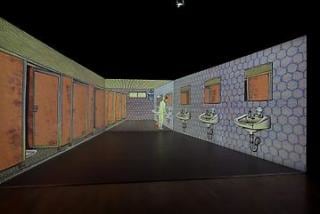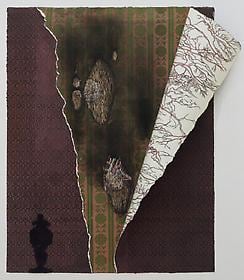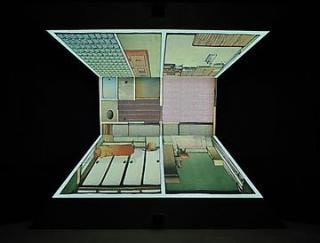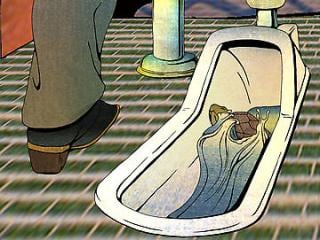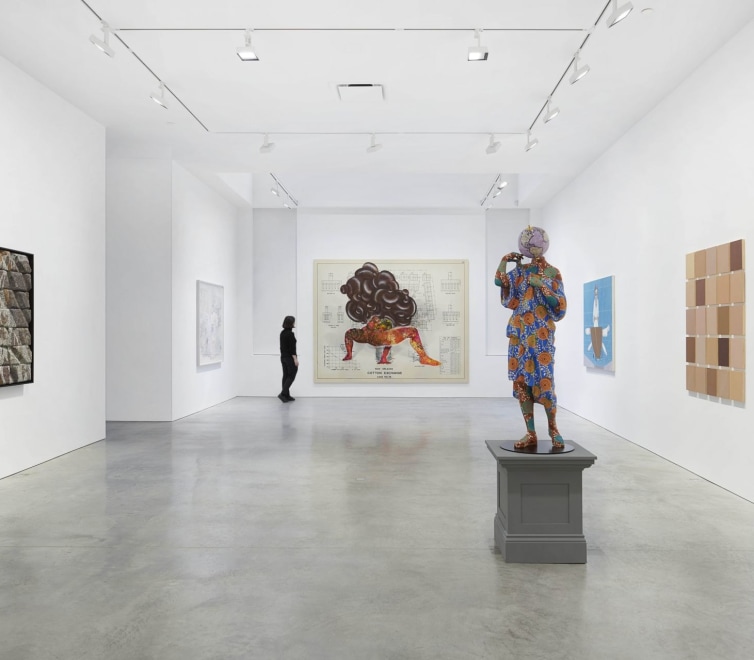
TABAIMO
Shinju Trail, 2018
Single channel video installation with custom frame
14 1/2 x 54 1/4 in.
36.8 x 137.8 cm
Running time: 4 min. 10 sec.
JCG9585
TABAIMO
Shinju Trail, 2018
Single channel video installation with custom frame
14 1/2 x 54 1/4 in.
36.8 x 137.8 cm
Running time: 4 min. 10 sec.
JCG9585
TABAIMO
Crow, 2016
Single channel
Dimensions variable
Running time: 4 min. 10 sec.
Edition of 5
JCG9054
TABAIMO
Crow, 2016
Installation view, Tabaimo, Clue to Utsushi, 291 Grand Street, January 13 – February 25, 2018
TABAIMO
The Obscuring Moon, 2016
Single-channel video installation with custom-built platform
Running time: 10 min. 36 sec.
Edition of 5
JCG9480
TABAIMO
The Obscuring Moon, 2016
Single-channel video installation with custom-built platform
Running time: 10 min. 36 sec.
Edition of 5
JCG9480
TABAIMO
The Obscuring Moon, 2016
Installation view, Tabaimo, Clue to Utsushi, 291 Grand Street, January 13 – February 25, 2018
TABAIMO
Two, 2016
Single channel
Edition of 8
JCG9484
TABAIMO
Two, 2016
Single channel
Edition of 8
JCG9484
TABAIMO
Two, 2016
Installation view, Tabaimo, Clue to Utsushi, 291 Grand Street, January 13 – February 25, 2018
TABAIMO
Chirping, 2016
Installation view, Tabaimo, Clue to Utsushi, 291 Grand Street, January 13 – February 25, 2018
TABAIMO
Chirping, 2016
Two-channel video projection with handmade Japanese scrolls:
Scroll Size: Each, 74 x 18 in.
188 x 25.4 cm
Image Size: Each, 38 x 13 in.
96.5 x 33 cm
Running time: 7 min. 36 sec.
Edition of 5
JCG9449
TABAIMO
Chirping, 2016
Two-channel video projection with handmade Japanese scrolls:
Scroll Size: Each, 74 x 18 in.
188 x 25.4 cm
Image Size: Each, 38 x 13 in.
96.5 x 33 cm
Running time: 7 min. 36 sec.
Edition of 5
JCG9449
TABAIMO
Flow-wer 12 , 2014
Ink, beeswax crayon, color pencil and pencil on Japanese paper
22 15/16 x 13 9/16 in.
TABAIMO
Flow-wer 10, 2014
Ink, beeswax crayon, color pencil and pencil on Japanese paper
17 5/8 x 13 3/4 in.
TABAIMO
Flow-wer 08, 2014
Ink, beeswax crayon, color pencil and pencil on Japanese paper
16 11/16 x 13 7/16 in.
42.4 x 34.1 cm
JCG7280
TABAIMO
Aitaisei-josei, 2015
Single channel video installation with sculptural elements
Running time: 6 min. 35 sec.
JCG7865
TABAIMO
Aitaisei-josei, 2015
Single channel video installation with sculptural elements
Running time: 6 min. 35 sec.
JCG7865
TABAIMO
Aitaisei-josei, 2015
Single channel video installation with sculptural elements
Running time: 6 min. 35 sec.
JCG7865
TABAIMO
Aitaisei-josei, 2015
Single channel video installation with sculptural elements
Running time: 6 min. 35 sec.
JCG7865
TABAIMO
TOZEN, 2014
Video installation
Running time: 5 min. 10 sec. loop
Installation view, Tabaimo: MEKURUMEKURU, MCA, 2014, Commissioned by the Museum Contemporary Art Australia
Photo: Alex Davie
TABAIMO
TOZEN, 2014
Video installation
Running time: 5 min. 10 sec. loop
Installation view, Tabaimo: MEKURUMEKURU, MCA, 2014, Commissioned by the Museum Contemporary Art Australia
Photo: Alex Davie
TABAIMO
TOZEN, 2014
Video installation
Running time: 5 min. 10 sec. loop
Installation view, Tabaimo: MEKURUMEKURU, MCA, 2014, Commissioned by the Museum Contemporary Art Australia
Photo: Alex Davie
TABAIMO
TOZEN, 2014
Video installation
Running time: 5 min. 10 sec. loop
Installation view, Tabaimo: MEKURUMEKURU, MCA, 2014, Commissioned by the Museum Contemporary Art Australia
Photo: Alex Davie
TABAIMO
Teleco-soup, 2011
Installation view, Tabaimo, ILLUMInations, 54th International Art Exhibition, La Biennale di Venezia, Venice, Italy, June 4 – November 27, 2011
TABAIMO
Teleco-soup, 2011
Installation view, Tabaimo, ILLUMInations, 54th International Art Exhibition, La Biennale di Venezia, Venice, Italy, June 4 – November 27, 2011
TABAIMO
Teleco-soup, 2011
Installation view, Tabaimo, ILLUMInations, 54th International Art Exhibition, La Biennale di Venezia, Venice, Italy, June 4 – November 27, 2011
TABAIMO
Teleco-soup, 2011
Installation view, Tabaimo, ILLUMInations, 54th International Art Exhibition, La Biennale di Venezia, Venice, Italy, June 4 – November 27, 2011
TABAIMO
Teleco-soup, 2011
Installation view, Tabaimo, ILLUMInations, 54th International Art Exhibition, La Biennale di Venezia, Venice, Italy, June 4 – November 27, 2011
TABAIMO
Teleco-soup, 2011
Installation view, Tabaimo, ILLUMInations, 54th International Art Exhibition, La Biennale di Venezia, Venice, Italy, June 4 – November 27, 2011
TABAIMO
Teleco-soup, 2011
Installation view, Tabaimo, ILLUMInations, 54th International Art Exhibition, La Biennale di Venezia, Venice, Italy, June 4 – November 27, 2011
TABAIMO
Teleco-soup, 2011
Installation view, Tabaimo, ILLUMInations, 54th International Art Exhibition, La Biennale di Venezia, Venice, Italy, June 4 – November 27, 2011
TABAIMO
Teleco-soup, 2011
Installation view, Tabaimo, ILLUMInations, 54th International Art Exhibition, La Biennale di Venezia, Venice, Italy, June 4 – November 27, 2011
TABAIMO
Teleco-soup, 2011
Video installation
Running time: 5 min. 27 sec. loop
Still image
TABAIMO
Teleco-soup, 2011
Video installation
Running time: 5 min. 27 sec. loop
Still image
TABAIMO
Teleco-soup, 2011
Video installation
Running time: 5 min. 27 sec. loop
Still image
TABAIMO
DanDAN, 2009
Video Installation
Running time: 4 min. 31sec. loop
Edition of 5
JCG5305
TABAIMO
DanDAN, 2009
Video Installation
Running time: 4 min. 31sec. loop
Edition of 5
JCG5305
TABAIMO
DanDAN, 2009
Video Installation
Running time: 4 min. 31sec. loop
Edition of 5
JCG5305
TABAIMO
BLOW, 2009
Four channel video installation on a semi-circular ramp with sound
Running time: 3 min. 42 sec.
Approximate room size required: 196.85 in. tall x 393.7 in. wide x 393.7 in. long
500 cm tall x 1000 cm wide x 1000 cm long
Edition of 3
JCG5306
TABAIMO
BLOW, 2009
Four channel video installation on a semi-circular ramp with sound
Running time: 3 min. 42 sec.
Approximate room size required: 196.85 in. tall x 393.7 in. wide x 393.7 in. long
500 cm tall x 1000 cm wide x 1000 cm long
Edition of 3
JCG5306
TABAIMO
Yudangami, 2009
Video Installation
Running time: 4 min. 13 sec. loop
TABAIMO
Yudangami, 2009
Video Installation
Running time: 4 min. 13 sec. loop
TABAIMO
Yudangami
2009
Video Installation
4'13" loop
TABAIMO
dolefullhouse, 2007
Single channel video installation with large panoramic screen
276 in. wide x 118 in. tall x 374.016 in. from projector
700 cm wide x 300 cm tall x at least 950 cm from projector
Running time: 6 mins. 23 sec. loop
JCG3703
TABAIMO
dolefullhouse, 2007
Single channel video installation with large panoramic screen
276 in. wide x 118 in. tall x 374.016 in. from projector
700 cm wide x 300 cm tall x at least 950 cm from projector
Running time: 6 mins. 23 sec. loop
JCG3703
TABAIMO
dolefullhouse, 2007
Single channel video installation with large panoramic screen
276 in. wide x 118 in. tall x 374.016 in. from projector
700 cm wide x 300 cm tall x at least 950 cm from projector
Running time: 6 mins. 23 sec. loop
JCG3703
TABAIMO
Public conVENience, 2006
Video installation
Dimensions variable
Running time: 6 min. 5 sec. loop
Installation view, Tabaimo, James Cohan, 533 West 26th Street, New York, March 14 – April 12, 2008
Photo: Jason Mandella
TABAIMO
Public conVENience, 2006
Video installation
Dimensions variable
Running time: 6 min. 5 sec. loop
Installation view, Tabaimo, James Cohan, 533 West 26th Street, New York, March 14 – April 12, 2008
Photo: Jason Mandella
TABAIMO
Public conVENience, 2006
Video installation
Dimensions variable
Running time: 6 min. 5 sec.
Edition of 3
JCG3701
TABAIMO
Public conVENience, 2006
Video installation
Dimensions variable
Running time: 6 min. 5 sec.
Edition of 3
JCG3701
TABAIMO
Guignorama, 2006
Video installation
Running time: 2 min. 36 sec. loop
Edition of 5
JCG5304
TABAIMO
Guignorama, 2006
Video installation
Running time: 2 min. 36 sec. loop
Edition of 5
JCG5304
TABAIMO
Guignorama, 2006
Installation view
Photo: Hirotaka Yonekura
TABAIMO
haunted house, 2003
Video installation
Dimensions variable
Running time: 4 min.
Installation view, Tabaimo, James Cohan, 533 West 26th Street, New York, March 14 – April 12, 2008
TABAIMO
haunted house, 2003
Video installation
Dimensions variable
Running time: 4 min.
Installation view, Tabaimo, James Cohan, 533 West 26th Street, New York, March 14 – April 12, 2008
TABAIMO
haunted house, 2003
Video installation
Dimensions variable
Running time: 4 min. loop
Edition of 5
JCG3702
TABAIMO
Japanese Bathhouse, 2000
3 channel video installation with sound
177 x 377 x 205 in.
449.58 x 957.58 x 520.7 cm
Edition of 3
JCG2242
TABAIMO
Hanabi-ra, 2002
Single-channel video animation
Running time: 4 min. 25 sec.
Projection: 157.4 x 118.8 in.
400 x 301.8 cm
Edition of 8
JCG2243
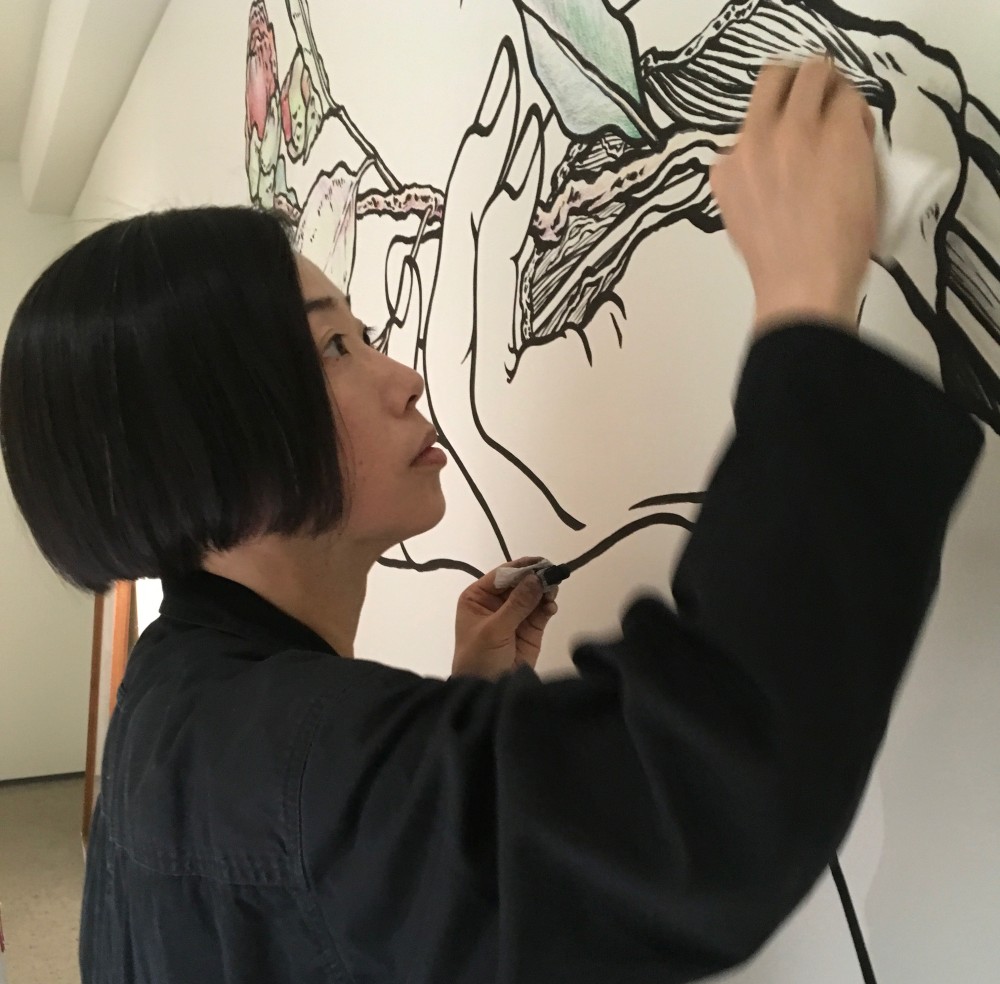
“A lurking, gnawing sense of dread, a fear that all is not well with the world persists throughout Tabaimo’s work. Be it a cook using human ingredients, a turtle being flushed down a toilet or nerves running between the floors of a dollhouse, the imagery that makes up the artist’s animated videos is at once nightmarish and alluring,” says Ashley Rawlings in ArtAsiaPacific magazine. Using drawings and coloration that evoke the hand-made nature of traditional Japanese woodblock prints (Ukiyo-e) and combining them with sophisticated computer technology, Tabaimo’s animated installations offer a surreal, complex and sometimes disturbing vision of contemporary Japanese society.
In 2011, Tabaimo represented Japan at the 54th International Art Exhibition, La Biennale di Venezia with a work titled teleco-soup. A completely immersive environment, the installation played with the idea of an "inverted" soup, or the inversion of relations between water and sky, fluid and container, self and world. Coined by the artist, this phrase builds upon an intellectual tradition in Japan that grapples with the country's identity as an island state, or what in recent years has come to be known as the "Galapagos Syndrome," originally used to describe the incompatibility between Japanese technology and international markets but now applicable to multiple facets of Japanese society in the age of globalization.
Tabaimo (born 1975, Hyogo, Japan), represented Japan at the 54th International Art Exhibition, La Biennale di Venezia (2011) and has been the subject of solo exhibitions at the Hammer Museum, Los Angeles, CA (2017); Asian Art Museum, Seattle, WA (2016); San Jose Museum of Art, San Jose, CA (2016); the Museum of Contemporary Art, Australia, Sydney (2014); Tabaimo: Boundary Layer, Parasol Unit Foundation for Contemporary Art, London (2010); TABAIMO: Danmen, Yokahama Museum of Art, Tokyo (traveled to the National Museum of Art, Osaka) (2009-10); Moderna Museet, Stockholm (2009); Fondation Cartier pour l’art contemporain, Paris (2006); YOROYORON: Tabaimo, Hara Museum of Contemporary Art, Tokyo (2006). International group exhibitions include: the Yokohama Triennale (2001); the Sao Paolo Biennale (2002); the 15th Biennale of Sydney, Australia (2006); and the 52nd International Art Exhibition, La Biennale di Venezia (2007). Interdisciplinary collaboration is also a major part of Tabaimo’s artistic endeavor; she has provided the visual elements to performances with Ohad Naharin’s Batsheva Dance Company, choreographer Maki Morishita, architect Yuko Nagayama, and photographer Hiroshi Sugimoto. Her work can be found in the collections of the National Museum of Art, Osaka; Hara Museum of Contemporary Art, Tokyo; the Israel Museum, Jerusalem; MUSAC, Spain; Fondation Cartier pour l’art contemporain, Paris; Moderna Museet, Stockholm; Museum of Contemporary Art, Los Angeles, CA; Asia Society Museum, New York, NY and the Museum of Modern Art, New York, NY. Tabaimo lives and works in Karuizawa, Japan.
“A lurking, gnawing sense of dread, a fear that all is not well with the world persists throughout Tabaimo’s work. Be it a cook using human ingredients, a turtle being flushed down a toilet or nerves running between the floors of a dollhouse, the imagery that makes up the artist’s animated videos is at once nightmarish and alluring,” says Ashley Rawlings in ArtAsiaPacific magazine. Using drawings and coloration that evoke the hand-made nature of traditional Japanese woodblock prints (Ukiyo-e) and combining them with sophisticated computer technology, Tabaimo’s animated installations offer a surreal, complex and sometimes disturbing vision of contemporary Japanese society.
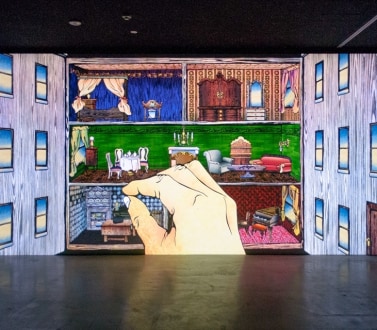


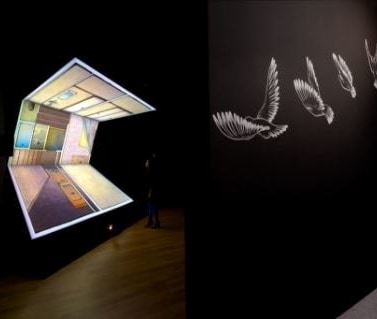
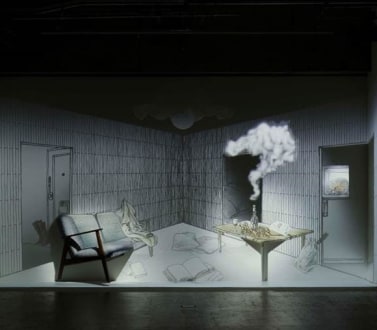
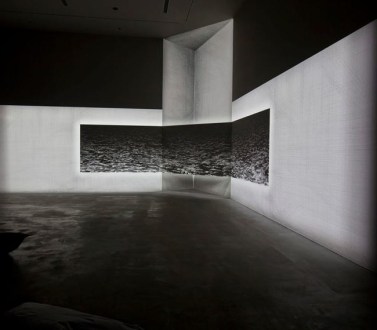
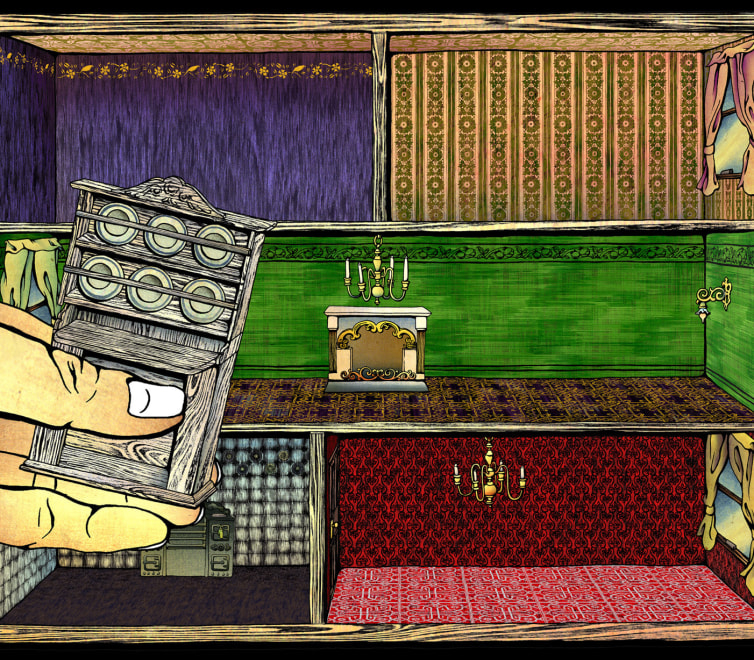
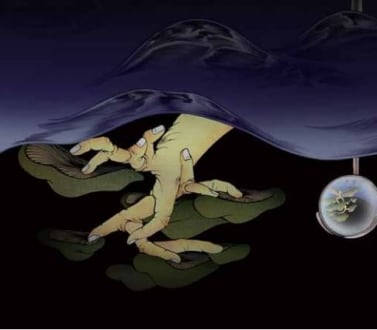
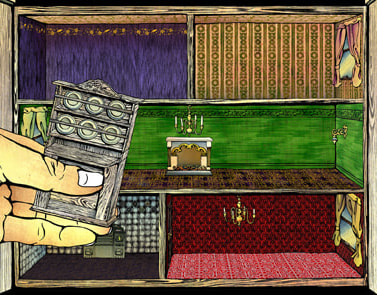
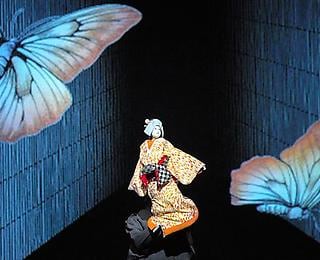
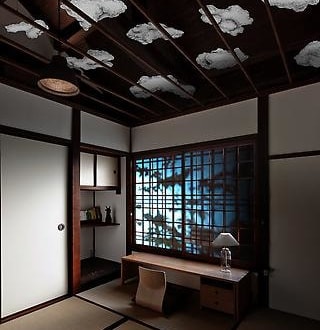
Uwajima, Japan

